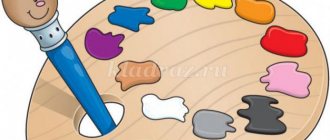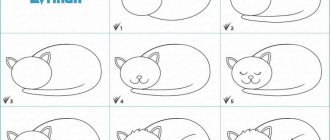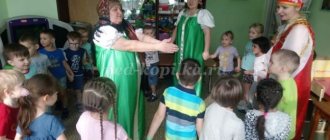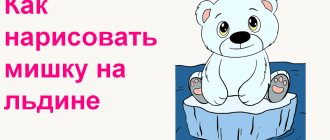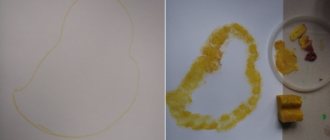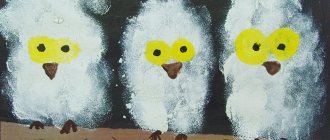Summary of GCD for drawing in non-traditional techniques in the middle group “Good fire, evil fire”
Vasilkova Tatyana
Summary of GCD for drawing in non-traditional techniques in the middle group “Good fire, evil fire”
Summary of GCD on artistic creativity in the middle group “Fire-good, fire-evil” (non-traditional drawing technique).
Author: Vasilkova Tatyana Leonidovna, teacher.
Preschool teachers and additional education teachers can use this summary to conduct classes with children in the middle group of kindergarten.
Target. To consolidate children's knowledge about fire, both good and evil, to continue to introduce non-traditional drawing techniques.
Tasks. Continue to teach the difference between good and evil fire.
Learn to portray characteristic emotions.
Develop speech, imagination, fine motor skills
To consolidate knowledge about fire safety, the ability to use non-traditional drawing techniques.
To cultivate neatness, imagination, curiosity, and a caring attitude towards your life and the lives of others.
Materials and equipment . A4 landscape sheet, gouache, brushes, sippy cup, napkins, cards with the image of good and evil lights, bells according to the number of children, a bi-ba-bo kitten toy.
Preliminary work . Creating a little book “Fire is a friend, fire is an enemy”, holding thematic discussions on fire safety, reading fiction “Cat’s House”, “Confusion”, “The Tale of a New Fire Engine”, playing board educational games “Fire is kind” fire-evil”, “Emotions”.
Progress of the lesson.
Organizing time.
A plaintive meow is heard.
Teacher : I wonder who it is! The teacher and the children go out into the corridor and see a kitten with a bandaged paw.
-Hello, kitten, what happened to you?
-Hello guys. I was visiting my cat's aunt, on her birthday, everything was fun, we danced, hummed songs, drank tea, then they brought in a cake with candles, they burned so beautifully, and then one candle fell on the floor and the carpet caught fire. The fire started and was barely put out, and I burned my paw. I thought the fire was good, but it turns out to be so evil!
Educator _ Poor kitten! Guys, let's help our Kitten.
Children: Let's go!
Educator: Guys, let's tell our kitten that fire can be not only evil, but also good! I will show you a picture with different types of fire, and you will tell me whether it is a good fire or not.
Didactic game: “Fire is good, fire is evil”
Children help choose the appropriate pictures.
Well done guys, see how different fire can be, kitten! Now let's remember the rules of conduct in case of fire:
Rule 1. Never touch dangerous objects.
Rule 2 . If you see a fire, immediately tell an adult, don’t be afraid, even if the cause of the fire is your prank.
Rule 3 . You cannot hide in far corners, under the bed, behind the closet - not only fire, but also smoke is dangerous.
Rule 4 . Remind your parents that firefighters are called by number “01.” Educator : Guys, do you know who firefighters are? (children's answers). That's right, these are people who put out fires and save people. To let them know that people need their help, they need to call the fire department at number “01”. But before they rang the bells so that everyone around them could hear: “There is trouble somewhere, help is needed!” Let's try to call the firefighters.
Dynamic pause.
Game "Bell"
Bells are heard to the children, music plays - the children run and ring the bells, the music suddenly stops - the bells fall silent.
Drawing. - Guys, now let’s draw our lights! Only in an unusual way, with our palms. First, we will place our sheet horizontally in front of us, take red gouache and paint over our palm. When the entire palm is painted, carefully and firmly press it to the sheet, raise the palm - 1 light is ready. Then we draw another light next to it in the same way. Let's finish painting our lights with the firewood from which it flared up, for this we'll take brushes and brown gouache. Now choose which light will be evil and which will be good?
Kitty. Thank you guys for explaining everything to me, now I know that fire is good, and if you handle it carelessly, it will turn into evil! Now I’ll run to my brothers and sisters and tell them too about the good and evil lights! Goodbye!
Reflection. Let's remember what we did with you in our lesson?
— What did you like most?
- Who came to visit us?
-Let's remember the rules that will protect us from fire.
Fire drawing technologies
Currently, several of the most accessible and simplest methods can be used to draw fire. The beginning of any drawing for inexperienced artists begins with the obligatory sketch in pencil.
In some cases, the image may remain made in a monochromatic technique, but you can color the constructed contours using colored pencils, felt-tip pens, watercolors, gouache, tempera, pastels and spray cans for painting in the graffiti style.
A novice artist chooses each method depending on the tasks facing him, and anyone can learn step-by-step drawing if they show a little patience and perseverance.
Fire flame with wood
Often there is a need to draw fire in stages with firewood, when children and young artists are busy creating entire series of pictures and comics.
A fire with wood will be built from two geometric shapes, one of which is a circle of fire tongues, and the other is a square or rectangular outline for the arrangement of burning logs.
The silhouettes of the firewood should be positioned in such a way that their cuts with annual rings and cracks can be seen, which will add more realism and picturesqueness to the work.
Having “folded” an imaginary woodpile on a sheet of paper using a hard pencil, you can draw a circle on top of it and begin to depict a burning fire.
Inside a limited circle, you need to draw zigzag tongues of fire, which are slightly lower in the foreground, and reach their greatest height in the center of the combustion.
Using an eraser, erase all unnecessary lines in the background and around the fire. Then the drawing is given final clarity of contours. Firewood is painted with dark brown pencils or paints with darker spots of bark, annual rings and cracks.
The lightest spot will be the place directly above the firewood, which, for greater contrast, can be left white, and above it an intensely yellow middle of the fiery flashes can be depicted.
The top of the tongues is painted dark red, almost burgundy towards the edges. Smoke around a fire can be shown either as white puffs with dark shadows inside them, or as a dark gray stream shaded with light highlights.
The environment always changes from the light of the flame, and in the picture this is expressed by the emphasized contrast of shadows on objects. The areas facing the flame will always be very light compared to the almost black shadow sides.
Pencil sketch of flame
Students may have a question about how to draw a fire for a school exhibition, staging a play, creating greeting cards with the image of the “eternal flame” or assignments on the theme of summer holidays and tourism.
For large works, it may be necessary to prepare several templates for sequential application of different colors on a painting or wall.
To create fire sketches you will need the following materials:
- basis for drawing - paper, canvas, wall, wooden or metal shield;
- a sheet of plain A4 paper for a sketch;
- simple pencils of varying degrees of hardness and softness;
- compass and ruler;
- eraser for erasing extra lines.
First you need to practice on a rough draft with a simple pencil. To do this, you need to beautifully distribute the flames in a given volume and outline gradations in the intensity of the fire in them, which will help show its dynamics and naturalness.
Even in a close-up and stylized drawing, the fire immediately becomes recognizable, thanks to the difference in the stripes of its brightness, which at the top gain maximum red color, and directly above the burning object are almost white.
